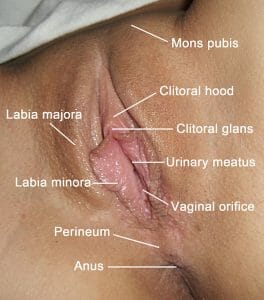Labia Definition
Labia refers to a part of the female genital anatomy that comprises the external region of the vulva (shown below). There are two pairs of labia in human women, termed the labia minora and the labia majora. The labia minora are the inner folds of skin residing under the labia majora. The labia majora are larger than the labia minora, flat in shape, and are often visible. The function of the labia is to provide protection for the vagina, clitoris, and urethra.
Labia Minora
The labia minora are two folds of skin situated under the labia majora that are devoid of hair. These folds protect the openings of the vagina and urethra, and the top portion connects with the clitoral glands and clitoral hood. At the posterior end of the labia minora, the folds meet under the opening of the vagina, at a location termed the frenulum of the labia minor. The surface of the labia minora contains sebaceous glands, sweat glands, erectile tissue, and an array of nerve endings. The labia minor are typically moist and only visible when the labia majora are pulled apart.
Labia Majora
The labia majora comprise the outer folds of skin, which are comprised of adipose tissue that results in a thickened appearance. The labia minora each cover one side of the vulva, meeting at the center, known as the pudendal cleft. The lower portion of the labia majora join below the frenulum of the labia minora and above the perineum, at a location known as the posterior commissure. The upper portion of the labia majora meet between the clitoris and the mons pubis, at a location known as the anterior commissure. Since the function of the labia majora is to protect the vulva, they typically cover all or the majority of the vulva. The outer surface is covered with pubic hair after the onset of puberty, whereas the inner surface is devoid of hair and contains sebaceous glands and sweat glands, as well as some nerve endings. In general, the labia majora are highly vascularized, and become engorged with blood during sexual stimulation.
Labia Growth and Development
Prenatal Development
At conception, the sex of an individual is determined by the presence or absence of the male and female sex chromosomes. In humans, the presence of the Y chromosome results in a male, whereas the X chromosome results in a female. During embryonic development, the Y chromosome will influence the development of the testis, which stimulate the production of the male sex hormones (i.e., androgens). In the absence of male sex hormones, female genitals will form. Such genital development typically commences at approximately four to six weeks of gestation and is known as the sexually indifferent stage because the genitals of both males and females develop in the same manner, forming two urogenital folds, a genital tubercle, and two labioscrotal swellings. Between eight and nine weeks of gestation, the urogenital folds become the labia minora and the labioscrotal swellings form the labia minora. Such changes are typically complete by 12 weeks of gestation.
Childhood
At birth, both the labia minora and majora are fully developed, exhibit a thick appearance the same colour as the rest of the body. However, during the first two years of life, the labia begin to flatten and smoothen, becoming less prominent. Since the labia are highly influenced by hormones, the thick appearance at birth is due to the presence of maternal hormones during fetal development, and the thinning appearance is due to the absence of such strong sexual hormones during early childhood.
After Puberty
During puberty, there is an increase in the secretion of female hormones (e.g., estrogen) which leads to changes in the appearance of the labia. The labia majora typically begin to thicken once again due to the accumulation of adipose tissue in this region. In addition, hair begins to grow on the outer surface of the labia majora, spreading and becoming thicker as it radiates outwards towards the mons pubis. The pubic hair covering the labia majora becomes increasingly thicker, coarser, and curlier as puberty progresses. After puberty, the outer surface of the labia majora darkens and wrinkles. Changes in hormones, such as during pregnancy, can also cause the labia majora to darken in color.
Old Age
Since the labia are highly responsive to changes in hormone levels, and in the absence of strong hormonal secretion following menopause, the labia change once again. After menopause, the labia begin to flatten due to the loss of adipose tissue, and become wrinkled. In addition, the thick hair that once covered the labia majora thins and turns gray. The elasticity of the skin comprising the labia diminishes and overall, the labia begin to atrophy.
Quiz
1. The purpose of the labia is to:
A. Protect the urethra
B. Protect the vaginal opening
C. Secretion of fluids
D. All of the above
2. During embryological development, the labia form:
A. In the absence of testosterone
B. In the absence of estrogen
C. In the absence of luteinizing hormone
D. In the absence of progesterone
References
- Clerico C, Lari A, Mojallal A, and Boucher F. (2017). Anatomy and Aesthetics of the Labia Minora: The Ideal Vulva? Aesthetic Plast Surg. 41(3):714-719.
- Gilbert SF. (2000). Developmental Biology Sixth Edition Sinauer Associates; Sunderland (MA).
- Marnach ML and Torgerson RR. (2017). Vulvovaginal Issues in Mature Women. Mayo Clin Proc. 92(3):449-454.
- Netter F. (2014). Atlas of Human Anatomy sixth edition Elsevier; New York (NY).

